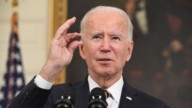【新唐人2012年12月01日讯】中共国务院副总理李克强,最近在中南海会见访华的“世界银行”行长金墉,他表示,中国已进入“中等收入国家”行列,未来中国必须跨越“中等收入陷阱”。但有专家认为,实际上中国距离“中等收入国家”行列越来越远。我们来听听专家们的分析。
所谓“中等收入陷阱”,是指新兴国家人均年收入达到3000美元水平时,积聚的矛盾集中爆发,经济增长因发展战略失误、或受外部冲击“回落”或“长期停滞”。那么,据“世界银行”统计,中国现时人均年收入为5400美元,已属于中高等收入国家(人均收入约3800至11900美元)。
因此,国务院副总理李克强向“世银”行长金墉表示,中国必须依靠国际视野和世界经验以跨越“中等收入陷阱”。
但是,纯粹依据中共当局提出的国民生产总值(GDP)数据和国民收入数据,来做分析和判定中国已经属于“中等收入国家”,令专家质疑。
美国“南卡罗莱纳大学”艾肯商学院教授谢田指出,李克强当年担任辽宁省委书记时,就曾亲自告诉美国大使,他不相信中国GDP的数字。李克强说,他自己通过发电、贷款、铁路运输的数字,来估计辽宁省的GDP数字。
“美国南卡罗莱纳大学”艾肯商学院教授谢田:“实际上他完全知道中国这个GDP数字是假的。如果中国整体国民经济最根本的数字都是假的,那这个国民收入数字一定是假的,一定是不可靠的。所以,依这个来作为依据,来判定中国已经进入中等收入国家,这我觉得是非常荒唐的。”
美国“普林斯顿大学”社会学博士,旅美中国经济社会学者程晓农也指出,目前,中国确实掉进了“陷阱”。但并非“中等收入陷阱”,而是收入分配不公造成的,可谓“经济增长困境”的陷阱。
旅美中国经济社会学者程晓农:“就是说,中国现在按人均GDP来讲,也许勉强算是中等收入国家。但是,一个很奇怪的现象,是全世界从来没有过的﹔就是,中等收入国家的特点应该是国民的消费和经济增长同步,但中国正好相反,消费在萎缩,而经济增长受益的不是国民,而是政府。”
据了解,1990年代,大陆国民消费平均占GDP的46%,但从2000年开始,这个比例迅速下滑,2010年降到约35%。程晓农分析,中国经济快速增长,但国民的消费占整个GDP的比重,却迅速萎缩,这在世界各国中是少有的现象。
程晓农:“经济增长的同时,大部分民众的国民所得并没有提高,所以消费力道迅速的相对萎缩。5%—10%的人,占有了整个经济成长绝大部分成果,而普通老百姓得不到任何好处,这就造成了一个很大的陷阱。拥有差不多十四亿人口的世界上最大的国家,它的消费不足以支撑这个国家的经济成长。”
近年来,中共总理温家宝曾多次谈论,中国的经济无法实现所谓的“可持续增长”问题。程晓农指出,即将上任担任总理的李克强,显然并没有充分理解温家宝面临的困境﹔或者,不能提出任何有效改善这种“收入分配结构”的办法,因为它和“政治结构”息息相关。
程晓农:“就是说,如果这个统治集团的群体,能够无条件的占有整个经济成长的成果,那么无论经济怎么成长,好处都到不了老百姓手里。实际上中国距离‘中等收入’越来越远。国民都能达到中等收入水平,这时候才谈得到所谓‘中等收入陷阱’,中国根本谈不上!”
程晓农分析,如果这个态势不转变,中国经济增长越快,老百姓的收入、消费的比例,下降的也越快。
采访编辑/梁欣 后制/孙宁
Experts: China Has Pulled Farther away from
“Middle-Income” Level
Vice Premier Li Keqiang of the Chinese Communist Party
(CCP) recently met with World Bank President Jim Yong Kim in Beijing.
Li said China has entered the ranks of
middle-income countries.
In the near future, China needs to skip the
“middle-income trap".
Experts say that in reality, China has increasingly
detached from the level of the “middle-income” countries.
The “Middle Income Trap" occurs when developing countries
Attain the level of US$3,000 per capita income,
its growth plateaus and eventually stagnates at that level.
World Bank’s data show that China’s current per capita
annual income is US$ 5,400.
And that China enters a tier of upper-middle-income country
(GNI per capita is US$ 3,800 to US$11,900).
Therefore, Li Keqiang said to Jim Yong Kim that
China must cross the “middle-income trap" by using worldwide experience for reference.
China’s entry into group of middle-income country was judged
on the basis of CCP official data on GDP and national income.
This conclusion has been questioned by experts.
Xie Tian, professor, Business School,
Univ. of South Carolina, says that
Li Keqiang, when serving as Liaoning’s Party chief,
told an American ambassador that he did not believe China’s GDP measure.
Li said that he used statistics of electricity production,
bank loans and freight transportation volume to estimate local GDP figures.
Xie Tian: “He fully knows the official GDP figures are
unreliable.
If such basic data in terms of China’s national economy is
inaccurate, the data on national income is certainly unreliable.
So it’s ludicrous to use these false figures to make a
conclusion that China is entering the ranking of middle-income countries.”
U.S.-based economist Dr. Cheng Xiaonong thinks that
China has fallen into a “trap”, but not the “middle-income trap".
It is a trap of “economic growth plight”, a result of unfair
distribution of income and wealth.
Cheng Xiaonong: “In terms of per capita income,
China may barely claim to be a middle-income country.
But it has a very weird fact which cannot be found
anywhere in the world.
In a middle-income country, its national consumption
always keeps pace with its economic growth.
But it’s just the opposite in China,
where consumption is shrinking.
However, the beneficiary of its economic growth is not
the populace, but the government.”
Reportedly, in the 1990s, China’s national consumption
accounted for 46% of GDP.
However, since 2000, the percentage has plunged,
and in 2010, it was down to 35%.
Cheng Xiaonong points out that this is a rare phenomenon
in the world.
That is, China’s rapid economic growth was accompanied
by a sharp fall of national consumption as a share of GDP.
Cheng Xiaonong: “The outward economic growth didn’t
improve most of civilians’ income.
So their consumption fell off. The vast majority of
economic growth is controlled by only 5%-10% of Chinese.
This has created a large trap in reality.
In a country with the largest population of nearly 1.4 billion,
consumption capability can’t support economic growth.”
In recent years, CCP premier Wen Jiabao has repeatedly
said that China’s economy cannot realize a “sustainable growth".
Cheng Xiaonong thinks that Li Keqiang, set to be new
premier, apparently has not yet fully discerned the plight that Wen faces.
Or, Li has not yet found any solution to ameliorate the existing
“structure of income distribution”.
This is because it is closely linked to the CCP’s
“political structure”.
Cheng Xiaonong: “That is to say, when this ruling elite group
can hold unconditionally all the fruits of the economy growth,
civilians would benefit nothing no matter
how the economy grows.
This actually pulls China farther away from the
“middle-income” level.
The basic premise of the so-called “middle-income trap" is
that citizens have all reached the middle-income level.
Now, China is simply too far from that ! “
Cheng Xiaonong warns that if this situation remains
unchanged, the faster the economy grows,
the quicker the civilian income and consumption
as a share of GDP will drop.



























